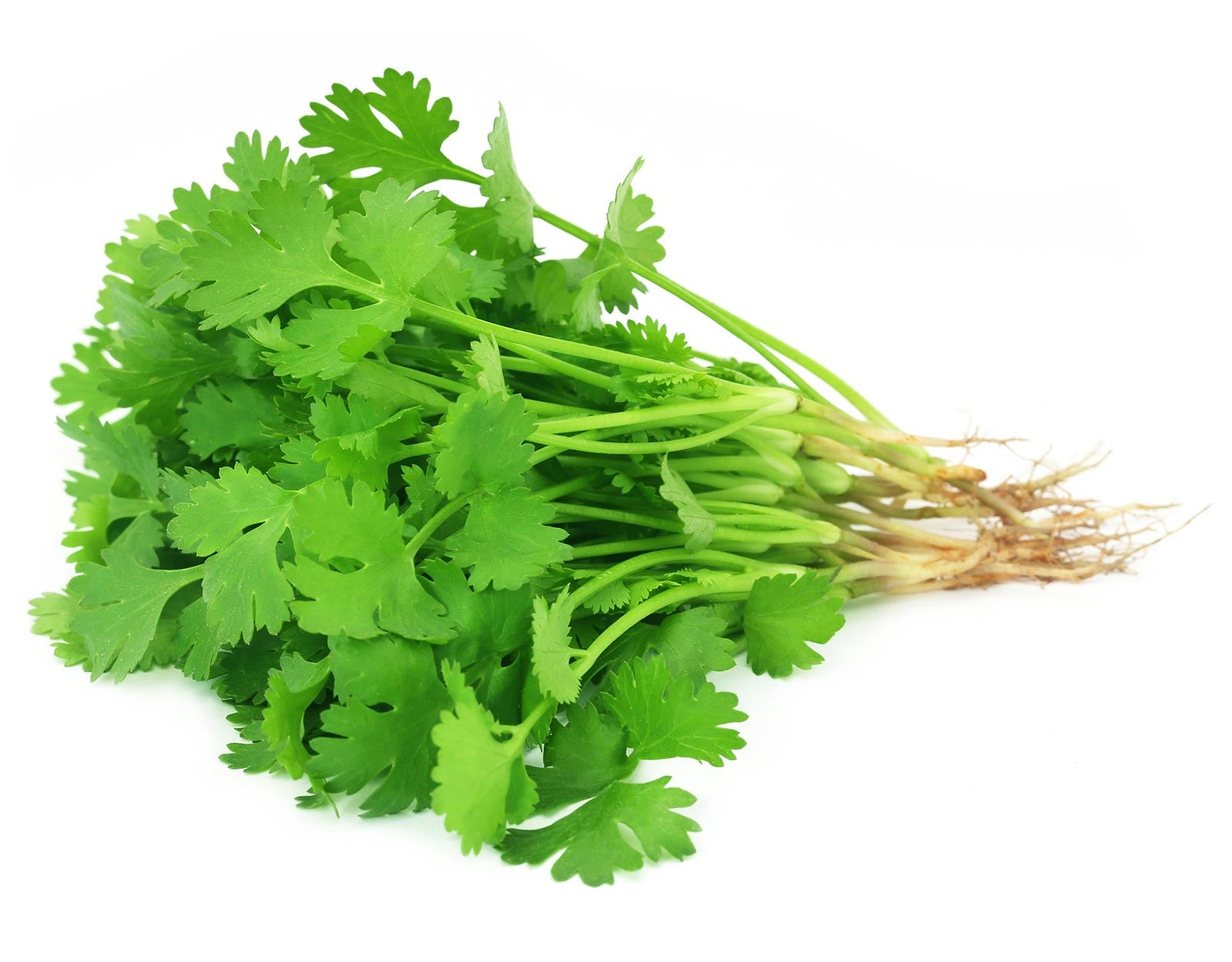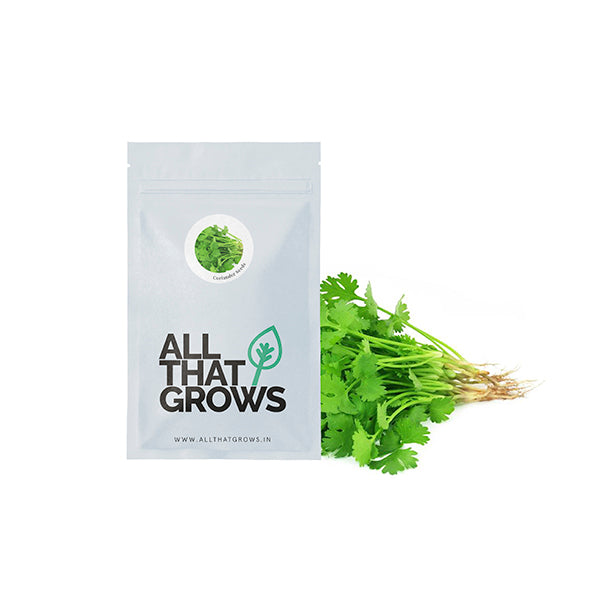



Coriander Seeds
Grow this with
Seed Type : Non-Hybrid, Open Pollinated and Non-GMO
Sowing Time : Recommended for year round sowing except May-June, thus very late bolting variety.
Plant Character : Plants bushy, profused tillering,numerous side branches
Leaf Character : Broad, dark green,very fragrant,leaves on side branches eatable even after bolting.
Cuttings : Number of cuttings can be taken till it bolts
- SOWING
TIMEYear round sowing
except May-Jun - Sowing
Distanceline to line distance - 9"
plant to plant - 6" - Fruit
WeightN/A
- Fruit
ShapeN/A
- Days to
maturity30 - 35 days
- Details
- How to sow
- Reviews
Coriander has long been used as a garnishing agent in almost all cuisines the world over. But there is so much more to coriander than just being an ingredient with a strong and much-loved aroma. Both a herb and a spice, coriander belongs to the Apiaceae family of flowering plants that also includes celery, carrot, and parsley. With origins in Southern Europe, Northern Africa, and South-Western Asia, it is mainly the fresh leaves and dried seeds in powder form that are consumed. The delicate looking and lush coriander plant is packed with extremely beneficial nutrients that both protect and regulate body functions. From being considered anti-diabetic to controlling cholesterol and free-radical production, the coriander does it all. Its healing properties are also said to be anti-inflammatory in nature. So now you know, coriander is not just a seasoning condiment but also particularly an excellent source of Vitamin A, C, K, calcium, manganese, magnesium and dietary fibre.
It is most famously used in salsa dips and chutneys, and generously sprinkled over soups, broths, omelettes and countless other dishes. If you are fond of coriander, you will find a way to include it in any and everything you eat. It's that simple! So go ahead and give your preparations the coriander kick!
Planting instructions
Plant coriander in spring after the last frost date or during fall. Do not grow in the summer heat as the plant will dry off. When the weather becomes warm, the plant will rapidly complete its life cycle and send up a long stem which will bring forth blossoms.
Plant the seeds in light, well-drained soil and space them 1 to 2 inches apart. Sow the seeds at 3-week intervals for continued harvest.
Space rows about 12 inches asunder.
It is important to keep seeds moist during their germination.
Growing Requirements
watering
Water the seedlings regularly throughout the growing season. They require about 1 litre of water per week for best growth.
pests
Coriander can be prone to the following pests- Fungal wilt, Leaf hoppers, Aphids, Mildew. Yellow leaves, water-soaked lesions on fruit, stunted growth, sooty mold caused by secretion of sticky substance called honeydew, shallow, dry wounds of fruits, etc are possible effects of these pests attack.
soil
Coriander prefers a loamy soil with an optimum pH range of 6 to 8.
spot
Requires full exposure to the sun. Choose a spot where it receives early morning or late afternoon sun, but be shaded during the hottest part of the day.
temperature
Cilantro grows best in temperature that is around 24 C (75 F). The ideal cilantro growing conditions are cool but sunny.
how to harvest
Harvest while it is low. Trim away the plant after the seeds fall and have it self-seed.
The large leaves can be cut individually from the plants. For the smaller leaves, cut them off 1-½ to 2 inches above the crown.
You can also remove the entire plant at one time; however, you will not be able to keep on harvesting for the residue of the farming season.
To store coriander seeds, cut off the seed heads when the plant begins to turn brown and set them in a paper bag. You can then store the seeds in sealed containers.
To store cilantro leaves, you can either freeze or dry them. To freeze, put the leaves in a resealable freezer bag and store them in your freezer.
To dry them, hang the plant in a warm position until fully dried, then put in the leaves in a resealable bag or container.

Customer Reviews
The productiveness of any seed we sell is subject to your local climatic conditions*, the sowing method you adopt, and your commitment to the planting process. We give no warranty, expressed or implied, and are in no way responsible for the produce.
Please note that all our seasonal recommendations/ sowing information is as per the local climatic conditions. *For more information on the optimum conditions required for growing seeds in your region, please contact us at, hello@allthatgrows.in or Whatsapp us at, +91 8544865077
Questions & Answers
Ask a Question-
Will the seeds germinate in the month of September? The weather is rainy and quite humid in North India.
Coriander seeds will germinate in September the only factor is that if the seeds are sown and start germination and then it rains ..then the sprout can die due to wetter logging ...in a covered area they will grow well!
-
How to grow coriander seeds. Do I have to soak it in water or teawater? How to prepare the soil? I bought coriander from the shops and tried several times to grow, but failed. That is why I am asking this question.
Hi,
To answer your query, please find the below link:
https://www.allthatgrows.in/blogs/posts/grow-coriander
We hope it will answer your all queries. Happy Gardening.
Regards,
Team AllThatGrows




Coriander Seeds
Seed Type : Non-Hybrid, Open Pollinated and Non-GMO
Sowing Time : Recommended for year round sowing except May-June, thus very late bolting variety.
Plant Character : Plants bushy, profused tillering,numerous side branches
Leaf Character : Broad, dark green,very fragrant,leaves on side branches eatable even after bolting.
Cuttings : Number of cuttings can be taken till it bolts
Grow this with
Coriander has long been used as a garnishing agent in almost all cuisines the world over. But there is so much more to coriander than just being an ingredient with a strong and much-loved aroma. Both a herb and a spice, coriander belongs to the Apiaceae family of flowering plants that also includes celery, carrot, and parsley. With origins in Southern Europe, Northern Africa, and South-Western Asia, it is mainly the fresh leaves and dried seeds in powder form that are consumed. The delicate looking and lush coriander plant is packed with extremely beneficial nutrients that both protect and regulate body functions. From being considered anti-diabetic to controlling cholesterol and free-radical production, the coriander does it all. Its healing properties are also said to be anti-inflammatory in nature. So now you know, coriander is not just a seasoning condiment but also particularly an excellent source of Vitamin A, C, K, calcium, manganese, magnesium and dietary fibre.
It is most famously used in salsa dips and chutneys, and generously sprinkled over soups, broths, omelettes and countless other dishes. If you are fond of coriander, you will find a way to include it in any and everything you eat. It's that simple! So go ahead and give your preparations the coriander kick!
Seed Type : Non-Hybrid, Open Pollinated and Non-GMO
Sowing Time : Recommended for year round sowing except May-June, thus very late bolting variety.
Plant Character : Plants bushy, profused tillering,numerous side branches
Leaf Character : Broad, dark green,very fragrant,leaves on side branches eatable even after bolting.
Cuttings : Number of cuttings can be taken till it bolts
- SOWING
TIMEYear round sowing
except May-Jun - Sowing
Distanceline to line distance - 9"
plant to plant - 6" - Fruit
WeightN/A
- Fruit
ShapeN/A
- Days to
maturity30 - 35 days
Planting instructions
Plant coriander in spring after the last frost date or during fall. Do not grow in the summer heat as the plant will dry off. When the weather becomes warm, the plant will rapidly complete its life cycle and send up a long stem which will bring forth blossoms.
Plant the seeds in light, well-drained soil and space them 1 to 2 inches apart. Sow the seeds at 3-week intervals for continued harvest.
Space rows about 12 inches asunder.
It is important to keep seeds moist during their germination.
Growing Requirements
watering
Water the seedlings regularly throughout the growing season. They require about 1 litre of water per week for best growth.
pests
Coriander can be prone to the following pests- Fungal wilt, Leaf hoppers, Aphids, Mildew. Yellow leaves, water-soaked lesions on fruit, stunted growth, sooty mold caused by secretion of sticky substance called honeydew, shallow, dry wounds of fruits, etc are possible effects of these pests attack.
soil
Coriander prefers a loamy soil with an optimum pH range of 6 to 8.
spot
Requires full exposure to the sun. Choose a spot where it receives early morning or late afternoon sun, but be shaded during the hottest part of the day.
temperature
Cilantro grows best in temperature that is around 24 C (75 F). The ideal cilantro growing conditions are cool but sunny.
how to harvest
Harvest while it is low. Trim away the plant after the seeds fall and have it self-seed.
The large leaves can be cut individually from the plants. For the smaller leaves, cut them off 1-½ to 2 inches above the crown.
You can also remove the entire plant at one time; however, you will not be able to keep on harvesting for the residue of the farming season.
To store coriander seeds, cut off the seed heads when the plant begins to turn brown and set them in a paper bag. You can then store the seeds in sealed containers.
To store cilantro leaves, you can either freeze or dry them. To freeze, put the leaves in a resealable freezer bag and store them in your freezer.
To dry them, hang the plant in a warm position until fully dried, then put in the leaves in a resealable bag or container.



 Sign In
Sign In








